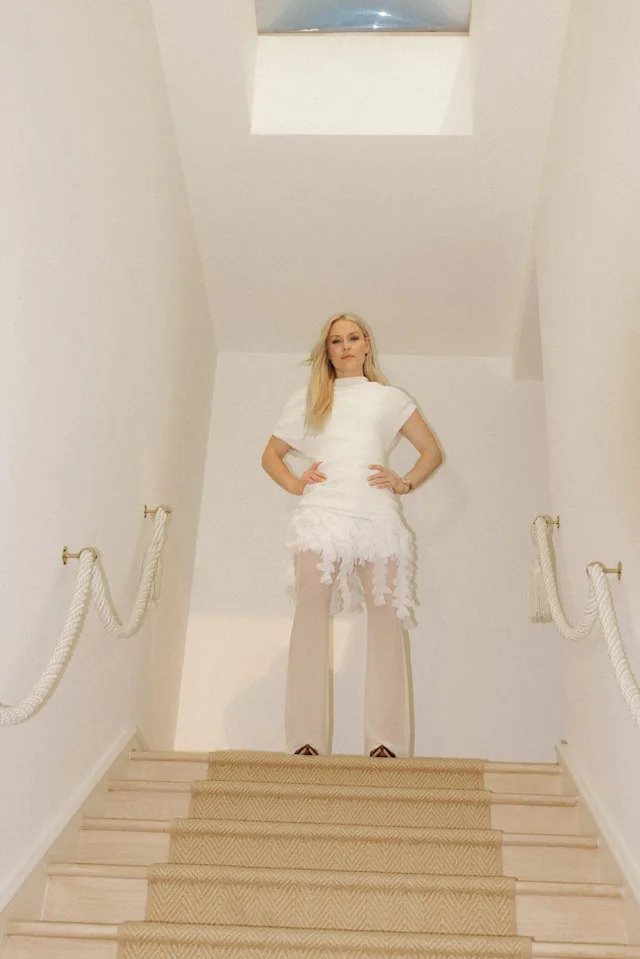You can absolutely call it a comeback. Six years after retiring as the most decorated female downhill skier of all time—eighty-two World Cup victories, three Olympic medals (one of which is gold), eight World Championship medals (including two golds)—Lindsey Vonn has returned to the high-octane world of professional downhill ski racing.
At forty, she’s more than a decade older than most of her competitors at the peak of the field—in some cases, nearly two—but with a brand-new knee and an equally fresh outlook, Vonn likes her chances. “I can do so much more than I could in the last few years of my career,” she says in late February via a Zoom call from Europe, where she is training. “I can lift heavier, and I can jump higher.”
Vonn’s body had been begging for a break long before her last official race in 2019. Some members of her team, she says, had been suggesting it may have been time to hang up the skis for as many as five years by then. After a devastating crash in November 2018—her third in nine months, this one resulting in three fractures and a torn LCL—she was finally ready too. “I was mentally beat down,” she recalls.
At first, retirement didn’t come easy. “It was hard to accept that something I loved to do so much was no longer there,” she says of the process. Vonn embraced therapy and self-reflection. She wrote a memoir, scrapped it, then rewrote it from scratch. (“I was in a bad place,” she says of her first attempt. “I grew a lot from that.” Rise: My Story released in 2022.) And while she says, even now, “I’m still figuring out who I am,” she did, in time, finally separate her sense of self from her sport. Vonn set up a life that stretched between Utah and Miami, where she picked up extreme water sports. “I couldn’t feel my knee,” she says of what she loved about wakeboarding and windsurfing. “So I felt more like myself.”
As she adjusted mentally, her body was still holding her back. “I was having a hard time living my life,” Vonn says, sounding almost amused, now so far removed from the physical experience. “I would go on walks with my friends’ seven-year-old and I couldn’t go more than ten minutes.” Vonn had spent her whole life up until that point scaling mountains just to zoom down them at eighty-plus miles per hour. Her walls were closing in. “It’s not fun to live in pain,” she says simply.

She met with doctors and researched her options for more than two years before deciding to pursue a partial knee replacement in April 2024. It went perfectly. And while the recovery was hard, Vonn was stunned by how good she felt. Soon she was daydreaming about a comeback. “My mind started to wander: What would I be able to do?” In November 2024, she announced her return to her sport.
If you’re wondering whether Vonn was worried about risking the health of her suddenly good knee all over again, you may not understand Lindsey Vonn. “I’m going to find adventure in something,” she says. “It’s not like skiing is the most dangerous thing I do in my life. I’m just not going to be happy sitting on the couch reading a book.”
Returning to racing has been a thrill, and the results of her first season varied between promising and stunning. Vonn was consistently among the top American finishers following her December debut, and in March she found herself on the podium once again in a World Cup race. She earned a silver medal—and a new record. Vonn is now the oldest woman to ever finish in the top three in any World Cup race.
Readjusting to the grind of training has been harder. After decades of living on someone else’s clock—coaches, tournament directors, camps—Vonn had settled into her own schedule. Now, “when you want to go support your sister, or whatever it is, you can’t be there,” she remarks. “I do miss that.” There’s no easy fix, she admits. “When you’re living out of your suitcase for months at a time, it’s a challenge to reset.”
